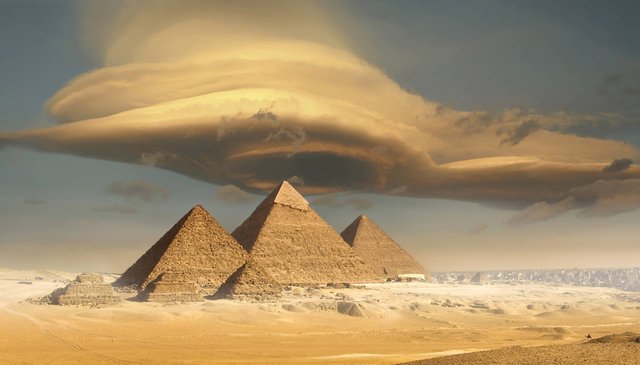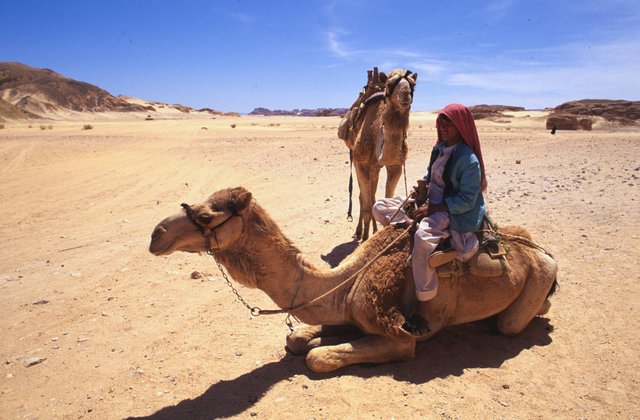The wonders of Egypt in 3 stops
A fascinating journey, from the interior of the Great Pyramid to the top of Mount Sinai

- The treasure of the pyramid
The experience of being in the heart of the Great Pyramid, built by the pharaoh Khufu (or Jufu) around 2600 BC (IV Dynasty) is amazing and also somewhat claustrophobic: by the rarefied air and the apprehension of being between two million and half of stone blocks, each of more than two tons. Many of the tourists who venture into it are unaware that the narrow hole that today serves as an access door is actually a butrón. The butronero was called Al Mamún, caliph of Baghdad in the ninth century, who expected to find the "30 red granite chambers full of precious gems, great riches, prodigious statues, unknown instruments and magnificent weapons" that are mentioned in the Kitab al Durr al Makmuz (The book of buried pearls), an ancient manual for treasure hunters. He was disappointed: he only found an empty granite sarcophagus (it is believed that the pyramid was sacked twenty centuries before Christ, during the First Intermediate Period).
Through the gap that Al Mamún ordered to open, we enter a narrow passage that leads to the Gran Galería, the steep ramp corridor nine meters high and 47 meters long that leads to the Cámara Real, a perfect and empty cube (except by the sarcophagus of Cheops) in the geometrical center of the immense polyhedron. The Great Pyramid has not yet revealed all its secrets: in 1954, a team of archaeologists led by Nancy Jenkins and Ahmed Youssef Mustafá discovered intact, in a well at the foot of the south face, the solar boat of Pharaoh Cheops, of perfumed wood cedar. In 1925 it was found, just 12 meters from its base, the intact tomb of Queen Hetepheres, mother of Cheops, and scientists equipped with robots, micro-cameras and scanners are still searching inside for hidden rooms and secret passages.

- Hator, lady of Dendera
To see one of the few portraits of Cleopatra that are preserved, you have to travel to Dendera, on the curve that the Nile draws north of Luxor, near Mena. There is the sanctuary of Hator, the Egyptian goddess of love, pleasure and beauty (although it was represented with cow ears). The Dendera is a late temple, built in Greco-Roman times, and the stylistic and temporal distance (almost 3,000 years) is abysmal with the sober, superb sanctuaries of the first dynasties, such as the temple of the Chephren valley, in Giza, or the even more ancient of Djoser, in Saqqara. It is, however, the best preserved and one of the most beautiful in Egypt. In one of its chapels was the famous horoscope that today is exhibited in the Louvre Museum, in Paris. Strategically placed skylights let the solar rays pass, creating a progressive play of light and darkness as one moves towards the sanctum sanctorum. Capitals adorned with the face of Hator finish the 24 columns of its hypostyle hall, and a bas-relief of its rear wall shows Cleopatra, the last queen of Egypt, with her son Caesarion, who was with Julius Caesar and was killed by order of Octavio, making offerings to the divinity. The hieratic image, in profile and framed in hieroglyphs, does not honor the passionate and beautiful Cleopatra of which Shakespeare wrote: "Age can not wither it, nor routine will freeze its charms".

- Dawn in the Sinai
It's three or four in the morning, it's still dark and it's cold, in the hotel they have distributed flashlights, although the clarity of the moon makes them unnecessary. Reapers of camels and sleepy tourists are grouped next to the walls and cypresses of the monastery of Santa Catalina, the fortress convent that Emperor Justinian had built in the year 530 in the foothills of Mount Sinai, in the place where the Book of Exodus says that Moses found the bush in flames. The road winds between large rocks; a row of lights on top of the mountain, at a distance that seems unattainable, to the position of the early riser group. The ascent, of more than four hours, becomes hard in the last section that leads to the top through 700 steps. The camel drivers know this and go up and down the path recruiting customers among those travelers who are running out of steam. Huddled in the small space of the summit, wrapped in blankets, pilgrims and tourists await the dawn. When it arrives "it is of an almost terrifying grandeur" (Pierre Loti, The desert).
wow that's great history very nice article